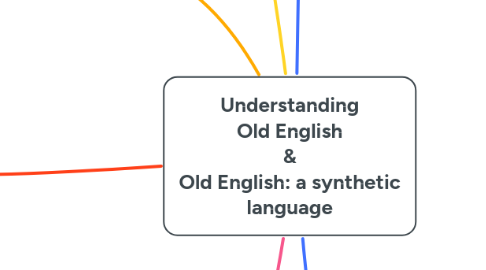
1. Spelling and Sound in Old English
1.1. Spelling
1.1.1. Knowing how to pronounce Old English will sometimes help you to work out what a particular Old English word means.
1.1.2. For example, pronounce the word Angelcynn
1.2. Sound
1.2.1. There are a few of the letters that are different and have sounds that you might not expect and you will need to watch out.
1.2.1.1. Grapheme : refers to the symbol or symbols used to represent a particular phoneme
1.2.1.2. Graph : A graph is one letter that represents one phoneme - ex. the graph <m> represents the phoneme [m].
1.2.1.3. Digraph : a two-letter combination that represents one phoneme - ex. The digraph [sc] represents the phoneme in Old English.
2. The Vocabulary of Old English
2.1. Present Day English (PDE) has borrowed vocabulary from many of the world's languages. wok from Chinese, rucksack from German, and coach from Hungarian. Sometimes words come directly from one language or sometimes via another. Coach, for example, while ultimately from Hungarian, was borrowed into English from French. Once a word has been borrowed it becomes absorbed into the language to such an extent that we no longer see it as ‘foreign’. In contrast, Old English contained far fewer borrowed words (though Latin was one source language) and was made up of predominantly Germanic vocabular. OE made great use of compounding to form new words. This is the practice of putting two (or more) words together to form a new word.
2.1.1. Word sae (sea) could becompounded with grund (ground) to form saegrund (seaground).
3. Old English: A Synthetic LanguageLanguage
3.1. The main difference between Old English and Present Day English is that OE is a synthetic (or inflectional) language whereas PDE is an analytic for isolating) language. An analytic language is one in which the grammatical function of the words and phrases in a sentence (i.e. the 'job' that they do in the sentence) is indicated by the order in which they appear.
3.1.1. 1. Oswyn shot Sigbert
3.1.2. 2. Sigbert shot Oswyn
3.1.3. 3. Shot Oswynx Sigbertz
4. Case, Gender and Number
4.1. In Old English, the grammatical function of nouns was indicated by an inflection on the noun in question. When we use a noun, we have to take into consideration three things: Its number–singular or plural. Its gender–masculine, feminine or neuter. Its case–how it's used in the sentence. Nouns, Pronouns, Adjectives, and Participles are declined in two Numbers (singular and plural) and in six Cases (Nominative, Genitive, Dative, Accusative, Ablative, Vocative).
4.1.1. The Nominative is the case of the subject of a sentence.
4.1.2. The Ablative may usually be translated by the objective with from, by, with, in, or at. It is often used with prepositions.
4.1.3. The Vocative is the case of direct address.
4.1.4. In names of towns and a few other words appear traces of another case (the Locative), denoting the place where: Rōmae at Rome rūrī in the country
4.1.5. The Dative is the case of the indirect object . It may usually be translated by the objective with the preposition to or for.
4.1.6. All the cases, except the nominative and vocative, are used as object cases; and are sometimes called oblique cases (cāsūs oblīquī)
4.1.7. The Accusative is the case of the direct object of a verb . It is used also with many of the prepositions.
5. Varieties of Old English
5.1. Old English and Scots
5.1.1. The Scots were originally from Ireland and settled in what is now Scotland around 500 AD. Also present in Scotland at his time were the Picts and it was not until 843 that Scottish and Pictish dominions were united by Kenneth MacAlpin, the first king of the Scots
5.1.2. As the language of the Picts gradually died out, the predominant language in Scotland became the Celtic language Gaelic.
5.1.3. A Scottish dialect of English emerged in the Middle English period, during the reign of Malcolm III of Scotland (1958-93)
5.2. Old English Dialectal Differences
5.2.1. Old English was relatively free in terms of word order. It should not be too surprising to learn, then, that most of the dialectal differences that can be noticed in Old English concern the sound of the particular variety in question
5.2.2. An example of the kind of dialectal difference we encounter in OE is that words which begin with an initial palatal consonant (a consonant produced using the palate ie the roof of your mouth - as an articulator), such as [g] or [k], are followed by diphthongs in West Saxon but by monophthongs (pure vowels) in other dialects
5.2.3. One way of investigating dialectal differences is to compare texts which exist in more than one dialect. One such example is Cædmon's Hymn.
5.2.4. The Northumbrian dialect contributed much to the development of Scout, which is just one reason why an awareness of dialectal variation is important if we are to account for the development of English over time.
